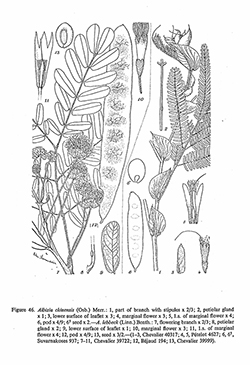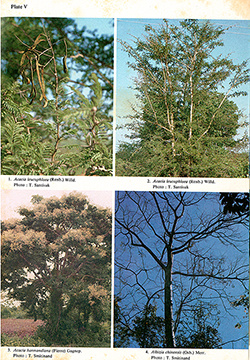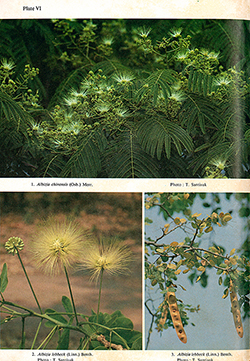e-Flora of Thailand
Volume 4 > Part 2 > Year 1985 > Page 188 > Leguminosae-Mimosoideae > Albizia
4. Albizia chinensis (Osb.) Merr.wfo-0000182103
Am. J. Bot. 3: 575. 1916; Back. & Bakh. f., Fl. Java 1: 553. 1963; Nielsen, Adansonia, ser. 2, 19: 221. 1979; in Fl. C.L.V. 19: 84. Pl. 15, 1–6. 1981.— Mimosa chinensis Osb., Dagb. Ostind. Resa: 233. 1757. Fig. 46: 1–6. Plate V: 4; VI: 1.
Accepted Name : This is currently accepted.
Synonyms & Citations :
Description : Tree up to 20 m high; branchlets terete, puberulous to tomentose, glabrescent. Stipules 1.5 cm long, ca 3 cm broad, auriculate, early caduceus. Leaves: rachis 10–25 cm; glands just below the junctions of the pinnae, ca 3 mm, and 1.5 mm high, flat to suburceolate; pinnae 4–14 pairs, 4–10 cm; leaflets (10–)20–30 pairs per pinna, opposite, sessile, chartaceous up to 1 by 0.3 cm, subulate-oblong, asymmetrical; base truncate, apex sharply acute; both surfaces faintly sericeous, main vein and margins tomentose; main vein forming the upper margin or nearly so; lateral veins prominent. Inflorescence: peduncles collected in a terminal puberulous to tomentose panicle up to ca 10–15 cm, or not panicled, peduncles up to 3–4 together in clusters, often surrounded by auriculate stipules at the base; 1–ca 3 cm, bearing heads of 10–20 sessile, dimorphic flowers. Marginal flowers: Calyx 2.5–5 mm, tubular to narrowly funneI-shaped, puberulous to tomentose; teeth 0.3 mm, deltoid, acute. Corolla 7–10 mm, funnel-shaped, puberulous to tomentose especially on the lobes; lobes 2–2.5 mm, ovate, acute. Staminal tube as long as to slightly longer than the corolla tube. Ovary glabrous, sessile. Pod up to 15 by 2 cm, oblong, flat, chartaceous, light brownish, indchiscent. Seeds ca 7 by 4–5 mm, elliptic, flat, 0.5–1 mm thick; areole near the micropyle, ca 1 mm diam., subcircular, pleurogram not parallel to the margins.
Thailand : N0RTHERN: Chiang Mai, Phrae, Nan, Lampang, Phitsanulok; NORTH-EASTERN: Loei; SOUTH-WESTERN: Kanchanaburi.
Distribution : Tropical and subtropical Asia (S China – type), also cultivated.
Ecology : Evergreen and deciduous forests, savannas, riverbanks, up to ca 1,800 m alt.
Vernacular : Kang luang (กางหลวง), san kham (สารคำ), san ngoen (สารเงิน)(Northern); khang hung (ค้างฮุง)(Northeastern).
Uses: As a shade–tree in coffee and tea plantations.



